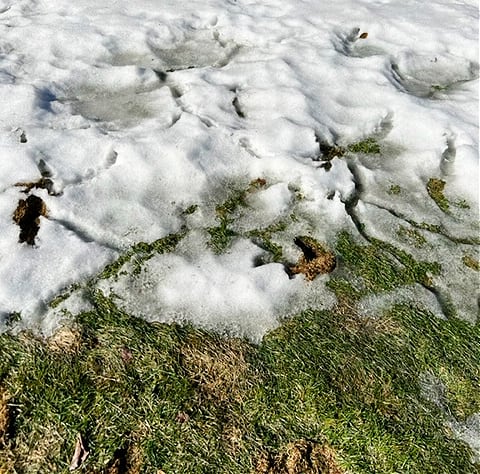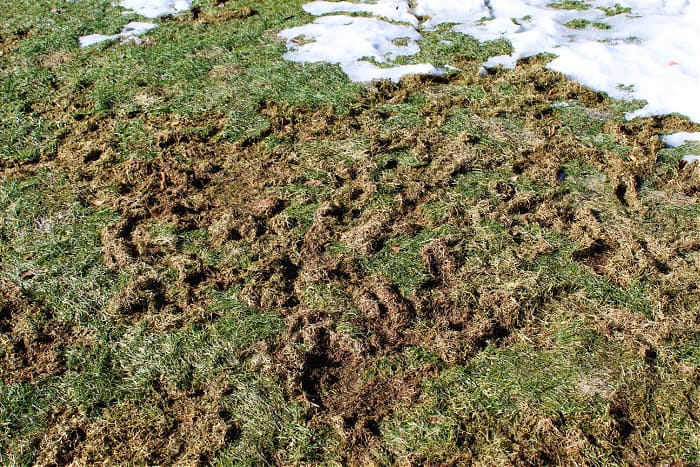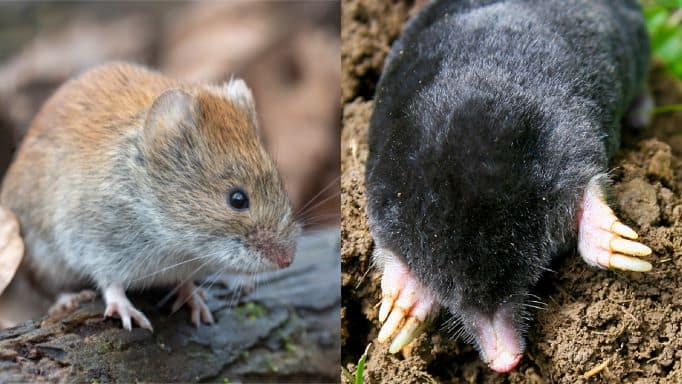Learn how to get rid of voles and prevent them from coming back before they damage your lawn, plants, and vegetables.
Voles can be one of the most damaging pests in your lawn and landscape. They create a vast network of tunnels along the surface of your lawn and landscape beds and they can multiply quickly if you don’t intervene as soon as possible. A vole can actually birth 5-10 litters a year with 3-6 offspring per litter. Luckily there are effective ways to prevent and get rid of voles if they are reeking havoc in your lawn and landscape.
Signs of Voles In Your Yard
There are a couple of easy ways to know if you have voles around your yard:
1. One of the easiest clues is the the presence of small 1-2” tunnels along the surface of your lawn (pic below). Voles don’t dig deep underground, instead they run along the surface making their tunnels visible. If you’re in a region where you get snow, one of the best times to see these tunnels is as the snow melts. You’ll notice little voids in the snow that are on the surface of your lawn. The snow offers the perfect protection for them since they don’t like to travel in the open.

2. You may also notice small holes in your lawn or landscape beds that are not mounded. Instead the holes lie flat on the ground. These holes are usually around trees or plants since voles dig down into the soil to feed on plant roots.
3. If you see plants that are dying and you can’t figure out why, give your plant the pull test. If it pulls out easily it’s because something ate the roots of the plant. Chances are this is from voles. If you look closely around the damaged plants you’ll likely see the other evidence (small holes, and tunnels along the surface nearby).
Vole Damage In Your Lawn
Voles are primarily vegetarians (although they are technically classified as omnivores), they feed on grass blades, plant roots, and stems. In your lawn, Vole damage is caused from their foot traffic, and eating leaf blades. On the plus side, damage to your lawn often appears to be way worse than it is. You may be shocked in early spring at how much damage there is, but as your grass starts to wake up and grow a lot of times the grass will fill in.
This is because Voles tend to cause damage to the leaf blades above the crown. The crown is the important part of the grass that is just above the surface of the soil. Usually if the crown is not damaged, grass will continue to grow from it. However, there are times where they can damage the crown and you will need to repair the damage.
Vole Damage In Garden Beds
In landscape and garden bed areas, voles can cause much more permanent damage. They can destroy plants without you even knowing it since they prefer to feed underneath the soil at the root structure of your plants. If you notice your plants wilting and dying back, it is probably too late. They got to your plant roots and it’s unlikely your plants will recover.
How to Get Rid of Voles
The key to controlling your problem with voles is early intervention, and persistency, using the products and prevention methods below.
1. VoleX–
VoleX is a scientifically formulated pellet that will poison voles without harming other animals or pets. It works by taking advantage of a unique characteristic found in voles digestive system. In fact there’s a great video here on how the science actually works: How Volex Works.
You can follow the application instructions on the label. You have the option to spread pellets directly into the tunnels and holes, or you can even broadcast the product over a large area. No matter which method you use just know that this isn’t a one and done treatment. Follow up treatments are definitely recommended, especially if you have a more significant problem.
2. Tomcat Snap Trap
Tomcat makes one of the easiest and most humane snap traps on the market. They are easy to set and bait. Peanut butter and apples slices are great baits if you want to use this method for extermination. Place the traps in the tunnel system where there is the most activity or place near holes. Just note, unlike the VoleX option, you could accidentally target other species.
3. Careful Where You Pile Snow
This is a simple prevention method. If you can keep snow off of plants and garden beds then it is much less likely that voles will go there. Voles don’t like to make themselves vulnerable, so they rely on snow cover to keep them protected from predators. If you have a garden bed near your house with plants that you want to go the extra mile to protect, try and keep that garden bed snow free. At the very least, when shoveling your walkway or around your house, avoid flinging snow into areas where there are plants.
4. Don’t Leave Grass Long
This is another easy prevention method. Much like how voles prefer the cover of the snow, they will also appreciate the cover from overgrown grass. Since they run along the surface of your lawn they will feel more protected if grass is left long. Don’t allow your lawn to get to a point where it is so long that it starts matting down and flopping over. This is the perfect environment for voles to travel through.
How to Fix Lawn Damage from Voles
In early spring, take a light rake to areas that appear damaged. Don’t rake too hard in early spring since the crown portion of the grass is very delicate and that’s where new growth will come from. When raking, any dead grass will come right up. Don’t over rake though, keep it light with little force.
Usually, this is the only thing that needs to be done. It’ll take several weeks but the grass usually fills in without the need to seed.
If you believe the damage is very extensive and you don’t see any small portions of the leaf blade still intact, then it might be wise to seed the area. Start by adding a thin layer of compost, and then throw down your seed. Don’t use top soil since top soil can contain weed seeds. After applying seed, If you want to cover the very top with Peat moss that will help protect the seed and keep it moist, but it’s not mandatory.
Also, don’t forget, if seeding you have to be careful with applying pre-emergents. Make sure to choose a pre emergent containing Mesotrione, which is the only pre emergent that can be used at the same time as seeding.
Overall, keep in mind that you may not need to repair your lawn at all. If damage is small with only narrow sections that are bare, you’ll likely see those sections fill in naturally. If damage is more severe, or your looking to speed up the recovery process then consider repairing damaged areas.
Voles Vs. Moles
If you were to ask most people what’s more common, a Vole or a Mole, they’d probably say “what’s a vole?”. For whatever reason, Moles seem to be the blame for everything but the truth is voles and moles are actually completely different in so many ways. Their physical characteristics, diet, and behaviors are not the same. Even their classifications are different since voles are rodents and moles are actually mammals. Take a look at the important differences below:
Physical Appearance: Voles look like field mice. They have small eyes and external ears. Moles on the other hand don’t have external ears. They have a more elongated snout and head and one of the biggest differences is that moles have paws that are more paddle like which helps them for digging below the surface.
Diet: Voles and Moles have very different diets. Consider voles to be the vegetarians. They are the ones that are eating your grass blades, and plant roots. Moles on the other hand almost exclusively eat bugs and insects. They are known to feed on grubs, earthworms, and other insects throughout your lawn and landscape.
Behavior: Another big difference is the way they move. Voles will run along the surface of your lawn, where moles will run underneath the surface. This pushes the soil up along the surface of your lawn. If you walk your lawn and feel raised tunnels of earth then this is from a mole that has dug a tunnel below the surface. Also, when you see an entry or exit hole from a mole, this hole in the ground is usually mounded. Holes from voles on the other hand are flush with the ground and are usually only near plants and trees.
If Moles are your problem check out this post: How to Get Rid of Moles
Vole FAQ
1. Are Voles Dangerous? Overall, voles are shy creatures and are not dangerous. If provoked, they can bite, but this is rare. They can spread
2. Do Voles Carry Rabies? Voles can carry many diseases including rabies, Machupu virus, Salmonellosis, and Leptospirosis. But, there is no documented case of a vole spreading rabies to a human.
3. Do Voles Hibernate? Voles do not hibernate. They are active all year and can breed throughout the year.
4. How Long do Voles Live? They usually don’t live longer then 12 months, but in their lifetime they can have anywhere from 15 to 60 offspring.
Check Out These Posts Next
White Grubs: Prevention and Treatment
Japanese Beetles: Control and Prevention
Join my free email list!




Thank you for voles and moles info can’t wait for next weeks blog on how to get rid of these guys.i have a severe vole and mole problem.i have even lost rose bushes,i have spent $500.00 on repellent but can’t get rid of them.
You’re very welcome Paul… I think you’ll have great success with the VoleX. Just remember to be persistent and keep re baiting areas. Good luck!
Please Help, It appears I may have a huge Vole issue. I live in Alaska we had tons of snow this winter. I have a peony garden with Thousands of dollars of plants. The snow just melted and I noticed the lawn had the slightest tunnel system everywhere. I don’t see anything in the flower beds yet. I started cleaning them yesterday and so I’m unsure if I destroyed any of the trails-damage that may have been there.
I’m not seeing any tunnel into the dirt to pour the VoleX into. I have no pets and no children at home. Please advise all my options. I’m desperate.
Hi Sandra! So if you have a widespread issue and can’t really figure out a main point to target, you can follow the broadcast spreader settings where you broadcast the VoleX over a large area. Check this out here: https://www.ecoclearproducts.com/products/volex Also, theres a good chance that the voles have moved on now that the snow has melted. That happens a lot on my property too. But for extra measure if you’re concerned about your plants I would probably spread Volex around your beds and nearby lawn areas.